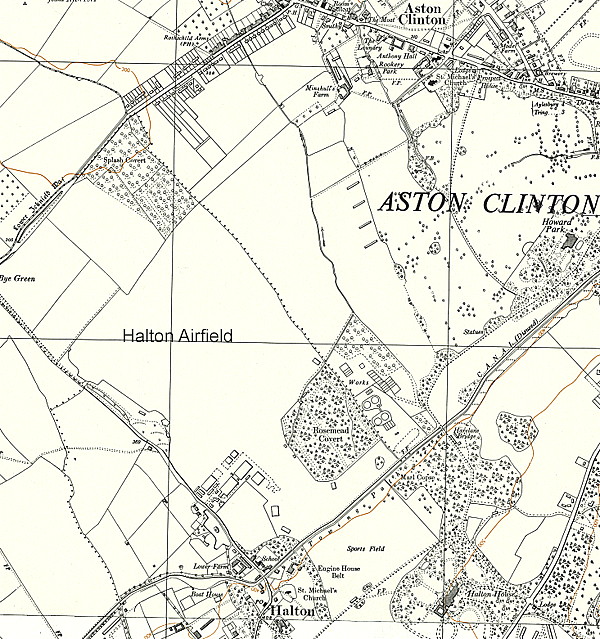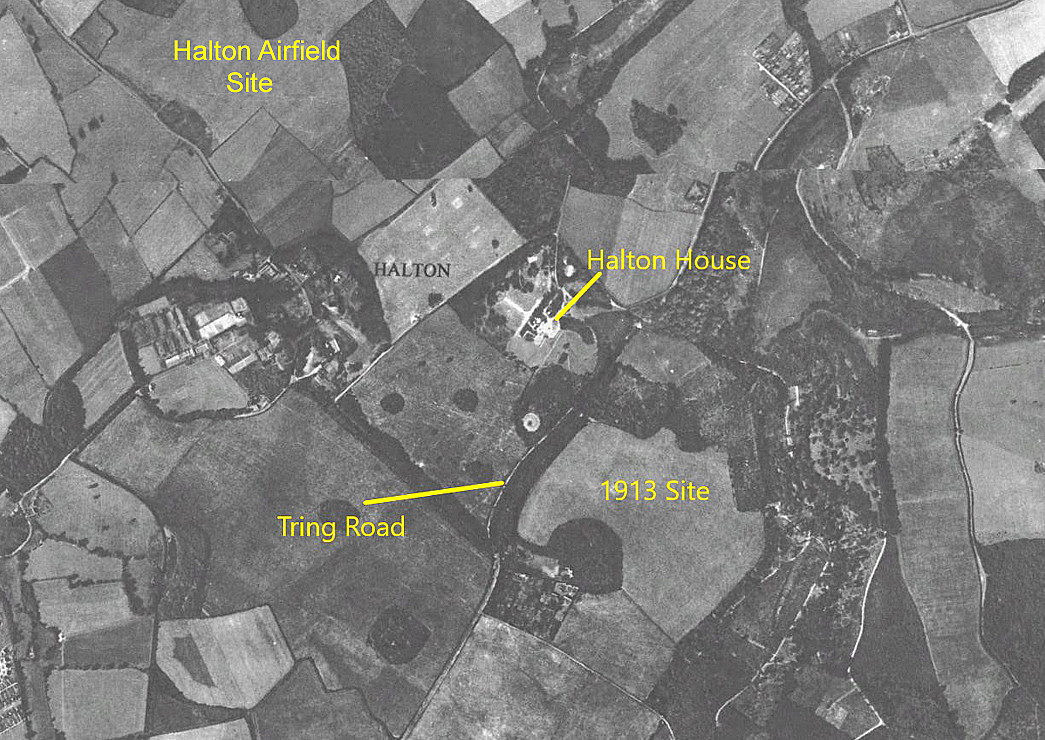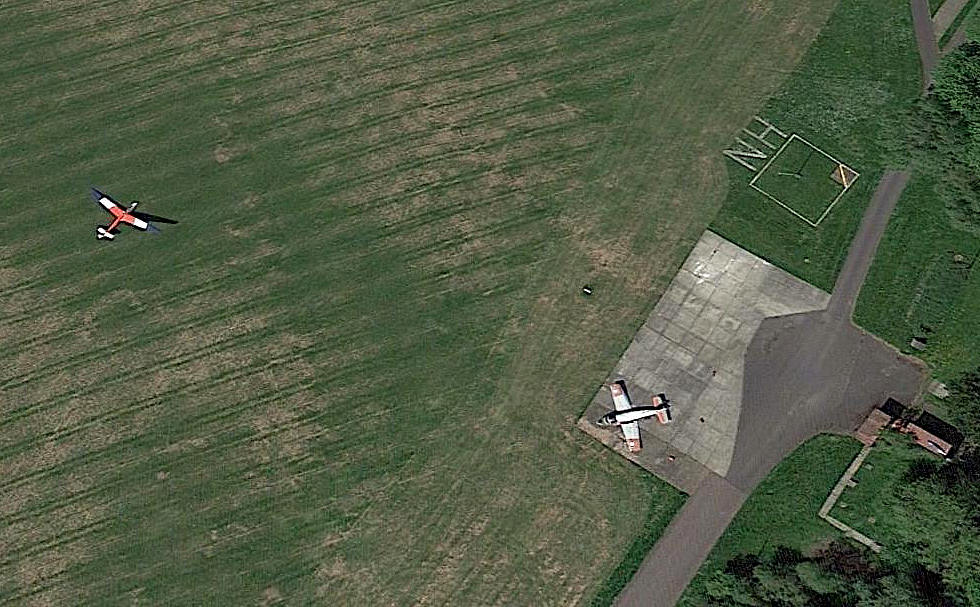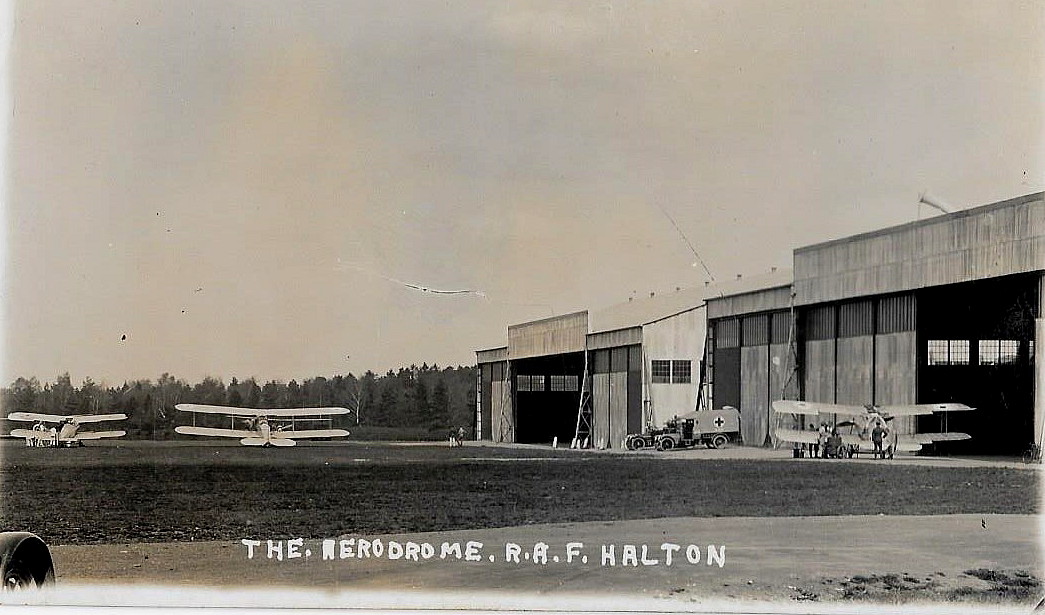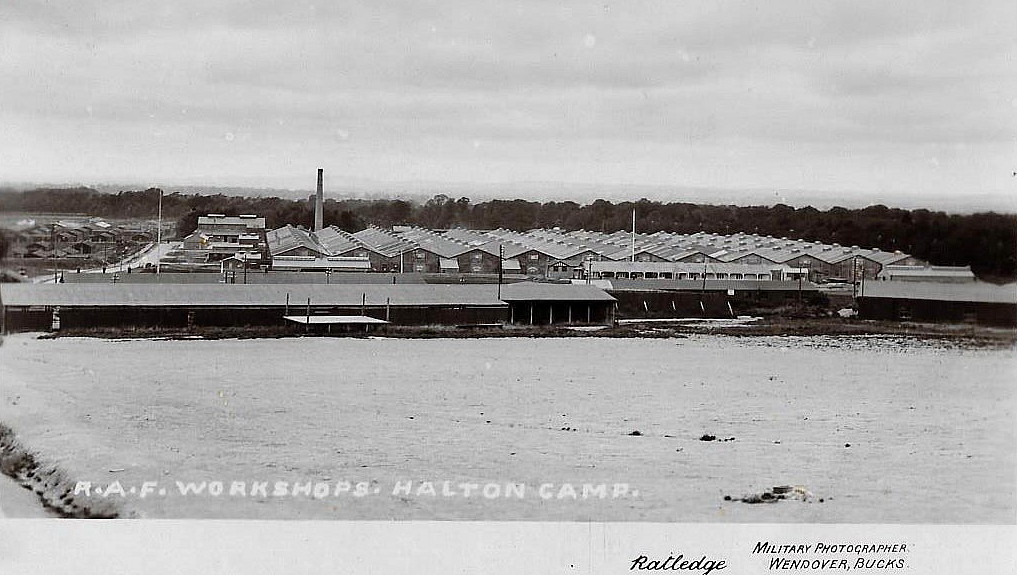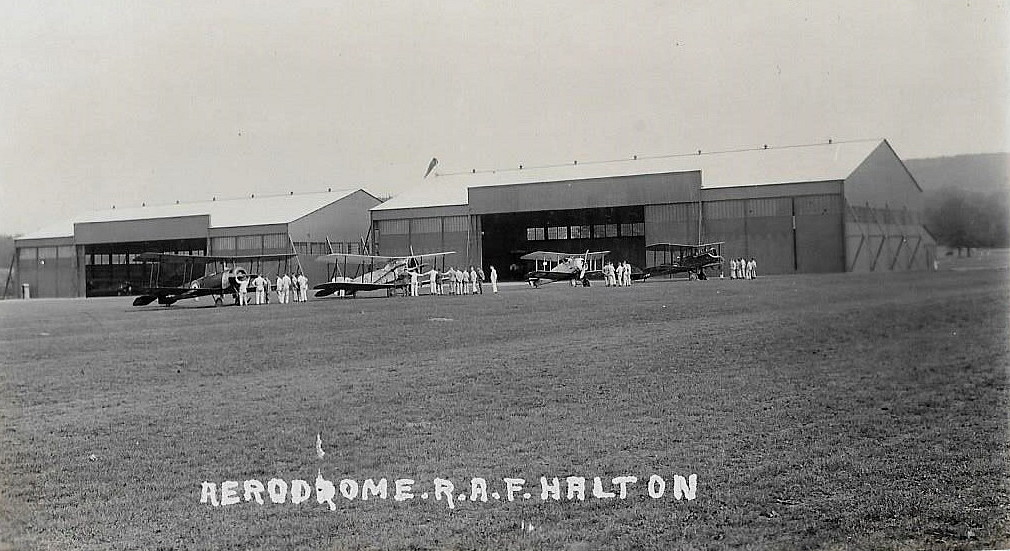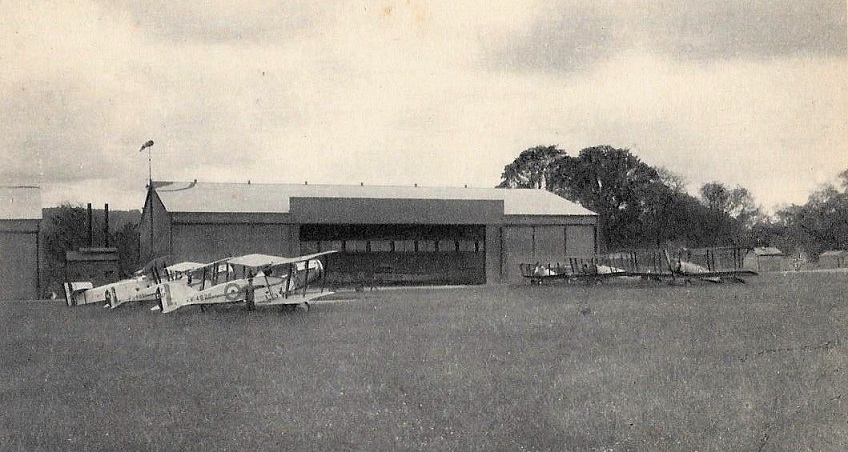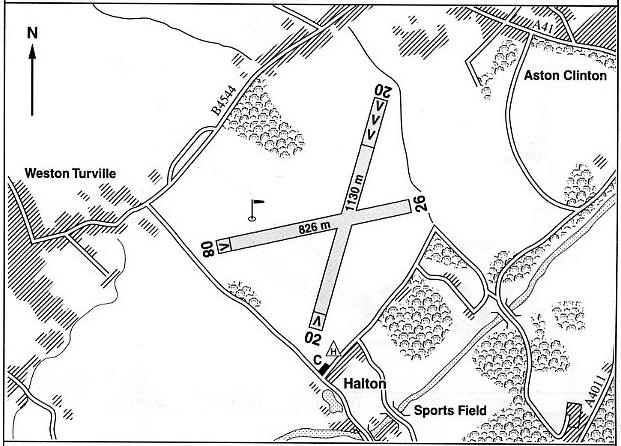Halton
HALTON: Military aerodrome (In WW1 also known as WENDOVER)
The first mention of aircraft at HALTON appears to be in 1912 when three aircraft, and an airship, arrived. Involved in military manoeuvres. We need to bear in mind that the majority of the top brass in the British Army were then, and remained so until well into WW1 had really got underway, very sceptical about the usefulness of fixed wing aircraft. Today of course all the emphasis regarding aeroplanes in WW1 is centred on the later fighters, and their ace pilots. The initial, and vital role of aerial reconnaissance tends to get overlooked, but if anything those largely unsung heroes flew much more dangerous missions, usually in obsolete types, although in reality the age of the aeroplane hardly mattered.
It appears that an airfield was later made available here by the Rothschild family in 1913. They owned Halton House as well as Waddesdon Manor, an even statlier pile on the other (west) side of Aylesbury, constructed in later part of the 19th century by Baron Ferdinand de Rothschild. But of course, in those days, having just one stately home was nowhere near sufficient.
The field selected was where the Maitland Parade Square and barrack blocks were constructed in the 1920s. Although the size was adequate, the location really was not suitable for committing aviation, which is why the later aerodrome, RAF HALTON, was laid out about a mile to the north.
A MICHAEL T HOLDER GALLERY
The first three items are from an article published in The Bucks Herald on the 27th September 1913 and gives a detailed account of the event.
It was during WW1 that Halton Park Camp was formed; initially, on the outbreak of the war Alfred Rothschild had offered the use of the estate to the British Army. However, General Sefton Brancker, then Deputy Director General of Military Aeronautics, (who was later killed in the R.101 disaster at Beauvais in France on the 5th October 1930), had put forward proposals to centralise the technical training of men, women and boys, and this led to the formation of the School of Technical Training (SOTT) at Halton.
It should be remembered that Sefton Brancker, later knighted, was, until his untimely death, a major foward thinking influence in both military aviation during WW1, and later in civil aviation. It was a very sad loss indeed and we can only conjecture as to how aviation in the U.K. might have evolved had he lived.
AN AIR PAGEANT AND MAPS
Note: The photographs were published in Flight magazine on the 2nd August 1928. Clearly an Air Pageant at HALTON involved much more than just flying displays. The inset picture of the de Havilland DH60X Moth G-EBYK, (in the first picture), is of interest because, unless my ageing eyes are mistaken, it seems to be a racing version with the front cockpit faired in?
Note: This sixth split picture shows 'Service' machines in the top section, and civil aircraft in the lower section. And, as can be seen, there were a lot of them. What we need to remember is that, during this period RAF pilots and civilian aircraft owners all came from, broadly speaking, the same social class. Mostly upper class and educated at public schools. (Has there ever been a greater distortion of our language than the term 'Public School'?). Nothing could be less so of course.
Note: The third picture, of the airfield name marked in a circle on the aerodrome, seems well worth remarking upon. This was common practice in the 1920s and 30s, for very good reasons. After WW2 I thought the idea had pretty much died out? It seems it died out here shortly afterwards - but what a shame. I do love to see people respecting the old traditions.
This said, many aerodromes still continue to have a 'Signals Square'. And why not? Can't say I ever took any notice of them when I was flying, simply because when joining a circuit they were too far away to see. And, if doing an 'overhead join' I already had all the information needed on the radio.
Note: All eight of these pictures were obtained from Google Earth ©
Eighth picture: Now a Jet Provost has appeared. Any info known?
Note: Pictures by the author unless specified.
Operated by: 2000: Royal Air Force
Military users: WW1: Landing Ground for the School of Technical Training Boys Training Depot and Australian Flying Corps Depot
THE MIKE CHARLTON GALLERY
Note: In September 2017 I was very kindly contacted by Mike Charlton who has an amazing collection of British aviation postcards. See - www.aviationpostcard.co.uk
As far as I can see all these pictures were taken in the interwar-years. If anybody can kindly offer advice regarding the dates and the aircraft types, this will be much appreciated.
LATER ON
In April 2018 Mike Charlton very kindly sent me this picture he'd recently acquired. And what a corker it is too.
In the front is the Airco DH.9A E9891. Then two Bristol F2B Fighters and beyond two Avro 504s - probably 504Ks?
1930s: No.1 School of Technical Training
WW2: RAF 24 Group SF Technical Training School
Post 1945: Still a major training establishment and flying activities werre mainly associated RAF training and communications types. Later GA private and training, microlight, and motor-glider types were/are based here. For ATC cadets etc winch launched gliders
1975: RAF (Chipmunks)
Aero club: Pre 1940: Halton Aero Club
Flying club: Post 1945: RAF Halton Aeroplane Club
Gliding: 1981: Chilterns Gliding Club (RAFGSA)
613 VGS
Note: Since 2004 HALTON has been the 'Centre' for the Royal Air Force Gliding and Soaring Association.
Location: S of the A41, SE of the B4544, about 3.nm SE of Aylesbury
Period of operation: 1917 to - (Continuous operation?)
Site area: WW1: 130 acres 762 x 700
Note: This map is reproduced with the kind permission of Pooleys Flight Equipment Ltd. Copyright Robert Pooley 2014.
Runways: WW2: N/S 914 grass NE/SW 567 grass
E/W 631 grass SE/NW 631 grass
1990: 02/20 1052 grass 09/27 762 grass
2000: 02/20 1130x45 grass 08/26 826x45 grass
NOTES: Home to the famous ‘Halton Brats’ who learnt their basic aircraft engineering skills here. The history is very interesting, not least because when the training centre at HALTON was formed, it followed a period when the very survival of the Royal Air Force was in question.
The Royal Air Force was established on the 1st April 1918 and it combined the Royal Flying Corps and the Royal Naval Air Service. However, when WW1 ended it had around two hundred and eighty squadrons operational but the political climate reflecting the attitude of the general public resulted in this force being swiftly reduced to just thirty squadrons – with much of the British Empire still to defend!
Patrick Bishop in his excellent book Wings does a great job of explaining the intrigues of this era and how the newly formed Royal Air Force had a struggle just to survive. In the end of it all, although not a fan of the Royal Air Force concept initially, ‘Boom’ Trenchard was appointed to run the struggling service and he had very definite ideas as to how its future would be determined, not least the concept that it would be entirely independent of the army and navy.
To quote again from Patrick Bishop: “The army and navy had offered the use of their facilities to train up volunteers. Trenchard spurned them. The RAF would have its own colleges in which to inculcate the ‘air spirit’. Cranwell in Lincolnshire for the officer cadets and Halton in Buckinghamshire for the apprentices.” Trenchard thought the relative isolation of the Cranwell site to train officer class aircrew was a positive advantage, divorcing them well away from Sandhurst (Army) and Dartmouth (Navy) influence. “Halton, on the other hand, was chosen for its proximity to London. ‘Trenchard brats’ – as the apprentices become known, (My note: Later known as Halton brats), - were thought to be more prone to homesickness and boredom. Halton Hall and the surrounding estate, bought from Lionel de Rothschild for £112,000, was within easy reach of dance halls and cinemas and the railway stations of the metropolis for parental visits.”
A QUESTION TO BE ASKED?
There is one aspect regarding the decision to base the engineering and electrical training facility at HALTON that I somewhat fail to understand. Most of the ‘traditional’ expertise in these areas was then based in the West Midlands, and, in or around northern cities. And, with the run-down of industry after WW1 the RAF could have ‘the pick of the bunch’. So, at first glance, it would seem to make more sense to establish a training centre much further north. On the other hand, as with Cranwell, it appears that Trenchard wanted, as far as possible, to start with a clean slate.
One thing seems absolutely certain. The training these apprentices received was mostly first class and the consequences went on for many decades. Even today many elder aircraft engineers and inspectors are very proud to have been trained at HALTON and quite rightly so. Patrick Bishop tells us: “The first appeal for apprentices had received an overwhelming response. Five thousand boys applied for the first intake of 300 places. They were mostly drawn from the lower-middle and upper-working classes, who saw the RAF as a way into the intoxicating world of aviation. The entrance exam tested them on mathematics, science and English. The candidates were expected to be a school certificate standard, a tough exam taken at sixteen, which was the threshold to higher education (it was a requirement for Cranwell).”
(My note: See CRANWELL, LINCOLNSHIRE, RAF Cadet College).
“…so most of the boys had parents who were prepared to keep them on after the normal school leaving age of fourteen. The sacrifices this must have entailed in some cases are evident in a 1924 magazine photograph of proto-apprentices as they set off from a London railway station to their new life. They are all cheering. Many wear shabby suits and flat caps. The caption noted that ‘the variety of class of boys was very striking, many of them having quite an imposing kit, whilst not the least pleased with the whole proceedings were those whose belongings were kept within bounds in brown paper parcels’.”
“The apprentices were divided into trades. They were to become fitters, working on engines, and riggers, responsible for the airframes. The third, smaller, category of wireless technicians was trained at a sub-unit of Cranwell.” Mr Bishop goes on to tell us: “In 1921 a new class of airman pilot was announced that offered flying training to outstanding candidates from the ranks. They served for five years before returning to their own trades, but retained the sergeant’s stripes they gained for being in the air. This policy meant that by the time the next war started about a quarter of the pilots in RAF squadrons were NCOs – a tough, skilful, hard-to-impress elite within an elite.”
And: “Trenchard was as proud of Halton as he was of Cranwell. He understood that he was engineering a new class of educated other ranks – something that had never happened in British military history.” He remained head of the RAF until 1930.
HALTON NOTES
In the 1920s the Halton Aero Club built a two seater, designed by C H Latimer-Needham, then the Education Officer at HALTON. It was named the Halton HAC.1 Mayfly and was, (it appears?), registered G-EBOO. The original intention was to have it ready to compete in the 1926 Light Aircraft Competition held at LYMPNE in KENT but the first flight took place on the 31st January 1927 from BICESTER in OXFORDSHIRE.
Once again I find this aspect of so many first flights both fascinating and frustrating to understand. Why did so many aircraft make their first flights from far-away airfields when a perfectly suitable airfield existed where the type was made? But, when was the airfield at HALTON laid out?
The Mayfly was later modified and called the Halton HAC.2 Minus, possibly because it was ‘reduced’ from being a two-seater to a single-seater? It appears to have been successful, along with its predecessor. Late Latimer-Needham designed the ‘Luton’ series.
A QUESTION?
I have found an intriguing note in a 1980s airfield guide saying that the based unit was No.1 SoTT operating Jet Provosts and Jaguars. I can’t quite believe Jaguars used this fairly small, (by RAF standards), grass aerodrome but did the Jet Provosts?
A COUPLE OF PERSONAL MEMORIES
On the 16th April 1997 Guy Browning and I arranged to make a visit to HALTON. It is of course quite a privilege to become a pilot and doubly so to be granted permission to land at an airfield which has had such a long association with the Royal Air Force. In many ways the equivalent of a cricket fan being invited to play a few overs at Lords.
A PRETTY SERIOUS GAFF
A few years before I had taken a passenger in a Cessna 152 for a tour of the area. In large part to show him many of the very impressive large houses and estates, which abound in this region. Probably after showing him Waddesfon Manor I headed back to Wycombe Air Park, and then spotted another one to look at. Which turned out to be Halton House.
After landing I learnt that I had invaded the HALTON aerodrome ATZ. Not by much, but still a serious offence. Fortunately all concerned were very kind and I got a telling off. I was of course appalled that I had failed to recognise the airfield at HALTON, and later realised one of the major problems in navigation when fling single engine types. The problem being that the airfield was hidden beneath the nose!
Gary Coleman
This comment was written on: 2015-10-19 20:59:09First flight at Halton was 18 September 1913. This was on a field where the Maitland Parade Square currently sits. The airfield was laid out as it is now in 1916, prior to that it had been home to hundreds of bell tents as Halton was an Army Depot until that point. The RFC technical training moved onto Halton from 1916 and the current 'old workshops' were built in 1917. The only hangars on the airfield until 1921 were Bessonaeu canvas types until the F Type Seaplane Sheds were built - these still stand today.
Reply from Dick Flute:
Many thanks indeed. Your help is much appreciated. Regards, Dick
Terry Clark
This comment was written on: 2018-01-10 05:20:19The entire area of land known as RAF Halton was given to the nation for use by the RAF with a covenant that if the nation ever had no further 'need' for it, then it must revert to farmland. Perhaps this is why No 1 SoTT was established here rather than up north. Whether this included the splendid Officers Mess, Halton House (not Halton Hall) I don't know but this being one of four chateaux built by the Rothschilds in the Vale of Aylesbury, I would think this would have to remain. My association with Halton started in the early '60s when as an ATC cadet I got my forat gliding experience there. As I approached my 16th birthday, I asked my Squadron Commander for a gliding course there commencing as soon as I was 16 and started training on 3 Oct 1964, 4 days after my 16th birthday,. going solo to gain my Air Cadet proficiency and BGA 'A & B' badges and certificates on 7 Nov 64. I became a Staff Cadet, eventually being cleared to carry cadets as passenger for air experience flights. Due to personal circumstances (mainly work after I had left school) I left in mid 1968. Fast forward to mid 1991.The OC of 2409 (Halton) Sqdn ATC decided there wasn't enough 'Air' in Air Training Corpsand revailed first on Thruster aircraft, then Cyclone Airsports to 'lend' him aircraft in which to fly cadets. I arrived on the scene, having obtained a PPL as part of my Air Traffic Control training and quickly adadapted to the Cyclone AX3 microlight to fly on behalf of the newly named 'Ridgerunners Microlight Centre'. We initially had 2 x AX3s plus a Thruster and flew cadets in them until late '95 when they were replaced by 4 x Chevvron 2-32c's. In addition to GMWHS (pictured) we had GMYGN (which I had originally flown with the maker, Angus Fleming, when he was testing a 45 hp engine instead of the 'standard' 32hp one) plus GMVOO and GMWJM. In late '96, these aircraft were used to run Microlight Flying Scholarships for Air Cadets, with some 19 cadets gaining 'Restricted' PPL(M)s and a 'special' flying badge was authorised for cadets to wear on their uniforms. Sadly both 613 VGS and the Ridgerunners have now gone, but the RAF Halton Areo Club and Micolight (no connection with the Ridgerunners) clubs still operate as does the RAFGSA Centre which moved in from RAF Bicester in about 1997. Yes there were Jet Provosts, Jaguars and Gnats at Halton up to the mid 90s when No 1 SoTT moved to Cosford, but they never flew. All 3 types were used to train the 'brats', the Jaguars in the massive workshops off the airfield with some of the JPs and Gnats actually on the airfield, the Gnats being used to train engine fitters and the JPs having an additional role in training 'Flight Line Mechanics', ie re-fuellers and marshallers. Gnats and JPs were often taxiied but never flew. During WW2, the main user I think was a radar calibration unit flying moslty Avro Rotas, although on one occasion a B17 landed in emergency, being unable to reach its base at nearby Cheddington.
Reply from Dick Flute:
Hi Terry, Many thanks indeed for this extra information. Best regards, Dick
Danny Roach
This comment was written on: 2018-07-28 19:11:39I'm doing some research on the use of the AX3 by the RAF/AEF and would be grateful if you could pass my email address on to Terry so that I may speak to him about his experiences at RAF Halton? Many thanks, Danny
Reply from Dick Flute:
Hi Danny, Could you kindly send your e-mail either as a comment or e-mail. I cannot access it on the web-site as it is hidden away in 'the back-office' programme. Regards, Dick
Gary Coleman
This comment was written on: 2019-11-23 23:08:37I was OC Ops Sqn at the airfield from 2006-2011. The picture labeled 1945 is much, much, earlier. I suspect it is around 1910 - the wooded copse that was in the middle of what is now the airfield was gone by 1917. The other thing to note is that 3x Vulcans and 2x Comet airliners landed on the grass airfield. If you search the internet you will find pictures of the aircraft at Halton. Sadly, they all left as scrap at the mercy of the scrap man’s oxy-acetaline torch. All the best.
Dick Flute
This comment was written on: 2019-11-24 20:20:39Hi Gary, Many thanks indeed - much appreciated. Your news about the Vulcans and Comets really is an eye-opener. I wonder if any copyright free pictures are around? Best regards, Dick
Michael Holder
This comment was written on: 2020-05-07 15:14:00Halton was a venue for an annual aero modellers meet back in the late 50s; it was always very well attended. There used to be an aircraft wreck on the airfield - near where your pin is on Google. It might have a been a Mosquito, but after 60 years the memory is going. I did visit the place in a Nimrod MR2 XV244 on 22 Jun 1985. I was on the wing staff at RAF Kinloss - Stn Nav - and the wing had the display crew duties for that year. It was a memorable day. After Halton we went via my parents house to Brize, then Newtonards in Northern Ireland, and our final display took place at Portree on the Isle of Skye. We were the talk of the island for the rest of the year - but that's another story.
We'd love to hear from you, so please scroll down to leave a comment!
Leave a comment ...
Copyright (c) UK Airfield Guide





















